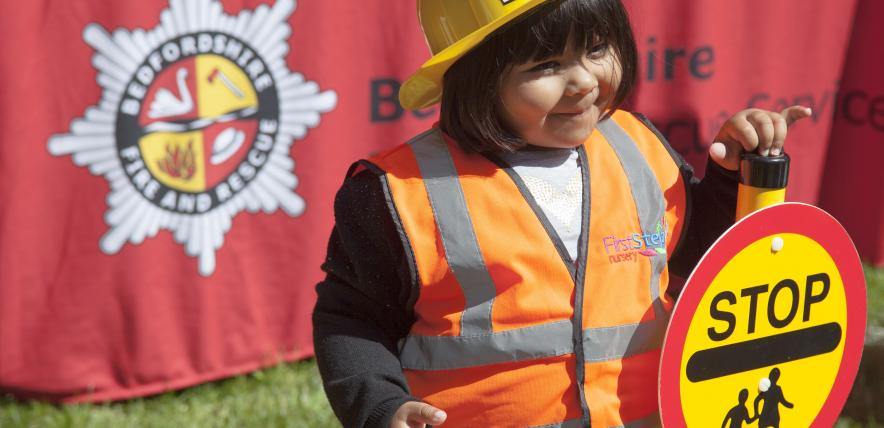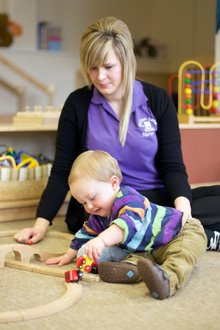It's never too early to introduce to your children the basics of road safety.
Even when they are still in the buggy you can begin to point out vehicles and start to develop their general awareness of traffic, roads and different names for vehicles.
There's no need to distress your child with doom-laden warnings, or that you reduce your child's exposure to the great outdoors — quite the contrary — but a gentle sparking of your child’s interest in roads and transport is the aim at this early stage.
By the time your child is regularly out of the buggy and walking you can begin to draw their attention to road users by playing simple games — looking for red cars, bikes, or counting lorries for example.
This is the time to begin to instill the building blocks of rules around road safety by talking about how fast cars travel and how careful we must be to stay away from roads.
You can begin to introduce road safety terminology such as pavement, road, traffic, fast, slow to your child in preparation for conversations about road safety rules.
The rules of ABC
The road safety charity Brake recommends talking about road safety in terms of ABC:
A is for awareness (traffic is dangerous and can hurt people)
B is for behaviour (things you should do to stay safer)
C is for choice and campaigning (how to make safer choices and to help others make these choices too).
Children from the age of two to eight are capable of understanding A and B. While children aged 8 and over will be more able to understand C.
Appropriate road safety messages for two-year-olds
At around the age of two when your child will be a more confident walker, commentate your road crossing rules and routine. The child will always be either strapped securely in a buggy or holding hands tightly, but they can still benefit from a basic understanding of what happens when out and about coming across roads, driveways and cycle paths.
Tell your child that we stop, look and listen before crossing, even when there’s a green man.
Explain that you are waiting to make sure it is safe to cross, looking and listening to check the road is clear.
It is important that your message is consistent and simple. Model the behaviour around roads and vehicles that you wish to see in your child. Remember that when you take risks you are teaching them to take risks too.
Appropriate road safety messages for three-year-olds
As they approach their third birthday your child will be growing in independence and physical ability and more than likely they will want to run and jump whenever they can.
Try to avoid letting your child use pavements - even on quiet roads - as playgrounds. What is safe one day may not be the next.
Help them to learn the limits around your local roads, for example ‘always hold hands all the way until we go through the park gate.’
Continue to reinforce the ‘stop, look, listen’ strategy, and ensure understanding that children should never go anywhere near a road without an adult, and that they should hold the adult’s hand without letting go.
Ask for your child’s help to look and listen to check if it is safe to cross, involving them in the process and enabling them to gain experience of making judgements.
Try to ensure that conversations and phone use are paused when traffic is present, for example in a car park, or when crossing roads. This will help your child to learn to associate these hazardous situations with being aware of any vehicles on the move, and to learn that full concentration is required for everyone’s safety.
When can children cross the roads alone?
As a parent of a pre-schooler it is your responsibility to keep your child safe around roads, and to promote an understanding of the importance of being extra careful anywhere that vehicles may appear.
Official advice states that children should cross with adults until at least the age of eight, because young children do not have the capacity to assess the speed of moving vehicles, have reduced ability to see clearly around them (and are less visible to drivers), and do not yet fully understand the concept of ‘dangerous’. They are more carefree and also more likely to act impulsively or be easily distracted.
They are also smaller and less visible to drivers.
To a certain extent, you need to be their eyes and ears for a few years, with the added responsibility of drumming the importance of ‘stop look listen’ into them.
Advice from Brake
Before the age of five parents can teach A — awareness
- Traffic is dangerous and hurts people
As the children get a bit older they can be told:
- Traffic hurts tens of thousands of people in the UK each year and people can be killed or seriously injured. (Note: many children may think minor injuries such as breaking an arm are okay or even fun – you may need to make clear how awful a serious injury is.)
- Some people do dangerous things when walking or cycling, such as texting on their phone while crossing a road. These people are more likely to hurt or killed.
- Some drivers do dangerous things, which increase the chance of them killing or hurting themselves or someone else, for example, speeding, or using a phone at the wheel, or driving after drinking alcohol.
- We have laws such as speed limits to stop people being killed or hurt in crashes, but some drivers break them.
Before the age of five parents can teach B — behaviour
Rules you can follow to stay safe:
- Paths and pavements are for people; roads are for traffic.
- Never go out near roads without a grown up. Hold their hand and don’t let go.
- Stop at once if you are told. Never try to cross a road until you are told.
- Don’t run into the road or play on roads - play in a park or garden.
- You can help grown-ups look and listen for traffic to cross safely.
- Traffic lights and other crossings help people cross the road. When a red man appears, it means you must stop.
- If you ride in a car, never undo your belt, play with door handles, or distract the driver.
By the age of five, children are also ready to learn:
- The Green Cross Code (find a safe place to cross, stop, look, listen, cross with care, looking and listening all the time).
- The safest places to cross: underpasses; footbridges; where there is a crossing-patrol (lollipop) person; traffic light crossings; zebra crossings.
- In a car, only get out on the pavement side.
- In a bus or coach or minibus, wear your seat belt if there is one. When getting off, never cross the road in front or behind the bus. Wait until it has pulled away so you can see in all directions.
Further information
Roadwise - The Green Cross Code
Where next?








